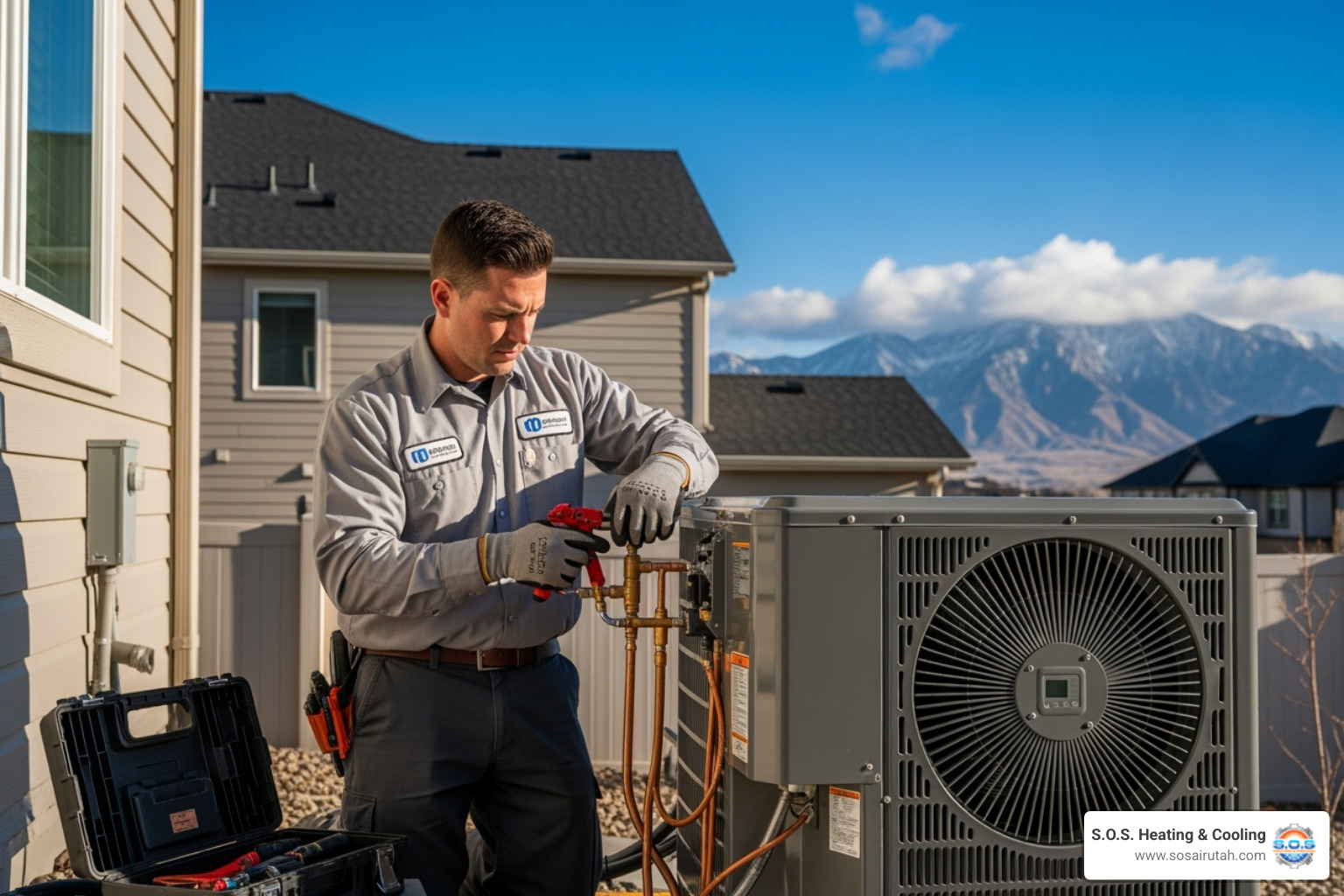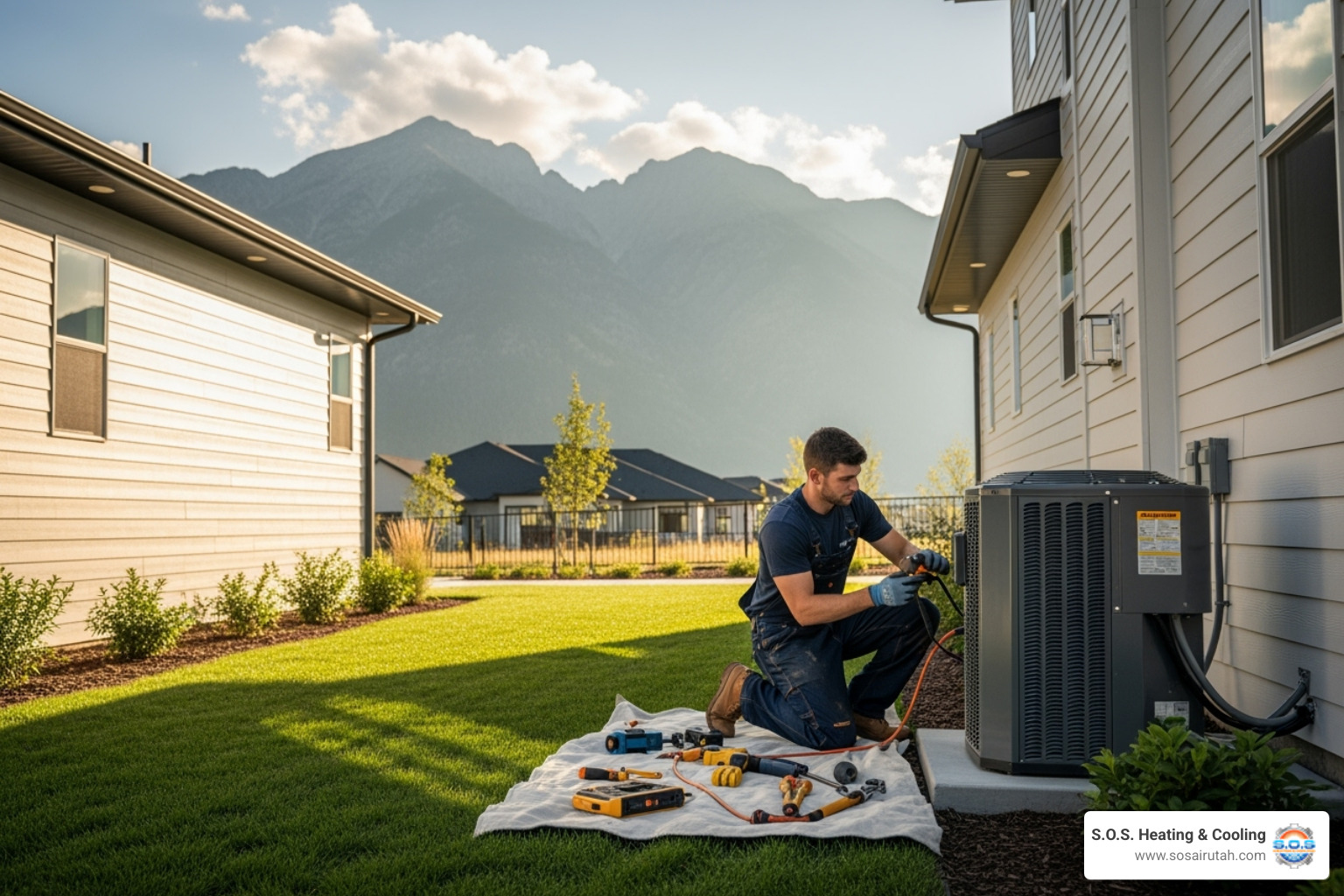
A blocked AC drain line might seem like a small issue, but in a summer climate like Draper, it can affect indoor comfort before you realize there's a problem. When your air conditioning system runs for long periods, it pulls water from the air and pushes it through a drain line. If that line becomes clogged, it can cause water to back up into the unit or even leak into your home. That’s often when homeowners notice wet spots around the indoor unit or sudden changes in how well their AC is working.
For a lot of residents in Draper, these problems tend to show up right as temperatures peak. And when cooling systems are operating at full capacity, a drain line blockage doesn’t just cut performance, it can create damage if left unchecked. Understanding what causes these clogs and how to catch them early can make a big difference in keeping your home cooler and drier through the hottest months.
Understanding the Causes of AC Drain Line Blockages
Drain line blockages don't always happen all at once. Sometimes they build slowly, and by the time the AC stops working the way it should, the issue has already created other problems. Knowing why these blockages form is step one in preventing them.
Here are some of the most common causes behind a blocked AC drain line:
- Buildup of dust and dirt: Over time, particles from inside the home or the unit get into the drain line. Once there's enough buildup, water can't flow out the way it's supposed to.
- Mold and algae growth: Since AC systems pull moisture from indoor air, they create a humid environment inside the drain system. That humidity often leads to growth of mold or algae, both of which can block the line over time.
- Rust or corrosion: Older drains made of metal or cheaper materials may corrode or rust, flaking off inside and contributing to the clog.
- Pet hair and debris: In homes with pets, hair can get into the system if filters are not regularly maintained. The same goes for large debris that gets past worn or loose seals.
High humidity, especially during peak summer in Draper, adds to the problem. It doesn't cause the blockage itself, but it speeds up how fast particles and organic material stick together inside the pipe. Left unchecked, that sticky layer gets thick enough to trap even more debris, and that’s when water stops flowing completely.
One example is when a family in Draper noticed their AC wasn’t turning off even after hours of running. It turned out the drain line had been slowly clogging due to mold buildup, and when water backed up into the system, the safety switch failed. That led to the coil freezing and shut down the cooling function entirely. What could've been a small fix turned into a bigger repair, and it all started with a clogged drain line.
The way homes are sealed these days to keep air in sometimes works against the system. Less airflow in the wrong places lets more particles settle inside ductwork and drain lines, compounding the issue.
Taking action before it gets to this point helps prevent breakdowns, water damage, and added stress on your cooling equipment. Blockages are common, but they don’t need to be constant. Watching for warning signs is key, and that’s where we’ll go next.
Signs Your AC Drain Line Is Blocked
When an AC drain line gets clogged, most Draper homeowners see the effects before they know the cause. The signs aren’t always dramatic, but they do start stacking up over time. Knowing what to look for helps prevent bigger problems and keeps your system running more efficiently during the summer.
Here are some of the warning signs worth paying attention to:
1. Reduced cooling performance – If your system is running longer than usual or struggling to cool rooms evenly, a blocked drain line could be backing up condensation. That moisture buildup can lead to frozen coils, and once that happens, cooling performance drops fast.
2. Visible water near the system – Water marks around the indoor unit, puddles under the furnace, or damp drywall nearby are strong signs of a drain line issue. Even a small leak signals that water isn’t draining properly.
3. Unusual smells – A musty or mildew-like odor around the vents or from the AC unit often means that moisture is sitting in the system. This stagnant water promotes mold growth inside the drain line, creating both odor and clogging issues.
If caught early, fixing a blockage is a straightforward task. If ignored, it can result in water damage, added stress on your AC system, and more frequent breakdowns. Residents in Draper see the worst cases in the middle of summer when the units are pushing out their peak output.
Steps Our Professionals Take to Fix a Clogged AC Drain Line
Fixing a clogged AC drain line takes more than pushing water through a pipe. Every step needs to be precise to make sure the line is fully cleared and the system protected from future blockages. Our professionals follow a structured process to get each drain line flowing again without guesswork.
The procedure typically includes:
- Inspection and diagnosis – The line and unit are first inspected to confirm the blockage and check for water damage or safety switch issues. Technicians will locate the clog and test the flow path.
- Line clearing and flushing – Using vacuum tools, pressurized air, or water solutions, our technicians break up and flush away any clogs. They also clean built-up debris that may be lining the pipe, not just the point of the blockage.
- Inspection for damage – Once the line is cleared, we check other components for signs of mold, leaks, or water buildup in the drain pan or around nearby electrical parts.
- Preventive solutions – Time is spent inspecting why the drain got clogged. Our technicians may recommend updated drain caps, adding traps, or minor adjustments to line pitch if needed to improve drainage.
The goal isn’t just getting water flowing again. It’s making sure that once fixed, the clog doesn’t come back and impact your home’s cooling performance again anytime soon.
How to Prevent Drain Line Blockages With Regular Maintenance
Many drain line problems are the result of buildup that happens slowly over time. That’s why regular maintenance is one of the most dependable ways to stop blockages before they start. Throughout the cooling season, moisture is constantly passing through that drain line, carrying fine particles with it. By keeping the system clean and routinely serviced, that drain line stays clearer longer.
Here’s what maintenance helps with:
- Clearing minor buildup before it becomes a clog
- Catching mold and mildew growth early
- Checking drain pans for standing water
- Testing that safety switches are working and shut-offs are protecting the unit
- Flushing the entire line if needed
To keep the drain line functioning in between visits, homeowners can also follow a few basic tips:
- Check the air filter every month and change it if it’s dirty
- Avoid stacking storage near the indoor unit that might block airflow
- Listen for any strange gurgling or trickling noises from the system
- Pay attention to musty smells or humidity changes in the air
These smaller steps don’t replace professional maintenance, but they support the AC system’s overall health. If done regularly, homeowners in Draper can avoid those midsummer headaches caused by a clogged drain line and keep their home cooler without sudden interruptions.
Staying Cool and Comfortable in Draper
In the middle of a Draper summer, a comfortable home depends on more than just low thermostat numbers. Something as simple as a blocked drain line can create big issues if it’s ignored. Water damage, mold smells, and inconsistent cooling all have a way of creeping up when the system is taxed by heat.
Taking care of the AC system’s drainage is one of those small services that protect your whole cooling setup. And catching the signs early makes it easier to fix before your home’s comfort is affected. Whether you’re seeing water leak near the furnace or your system seems to be struggling, it’s worth getting it looked at before anything worse develops.
Scheduling seasonal inspections helps extend the life of your AC system and avoids being caught off guard when temperatures spike. Reliable cooling starts by keeping every part of the system performing the way it should, including the small ones like your AC drain line.
If your system shows signs of a clogged drain or uneven cooling during these hot Draper days, trust S.O.S. Heating & Cooling to resolve the issue with care. Learn more about AC repair in Draper to keep your home comfortable and your system running smoothly. For a quick estimate or to book a service visit, please contact us today.
Explore Our Latest Insights and Updates in Plumbing Services

Stay Productive: Top Commercial AC Services in Utah

Budget-Friendly Breeze: Your Guide to Affordable Air Conditioning in Utah

The Ultimate Guide to HVAC Maintenance in Utah






.avif)